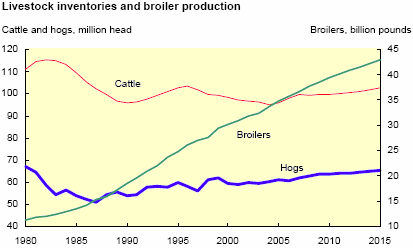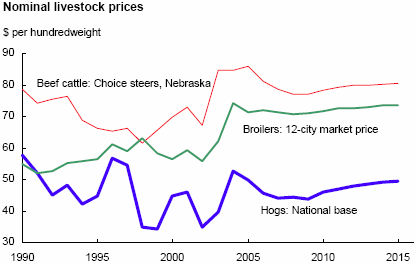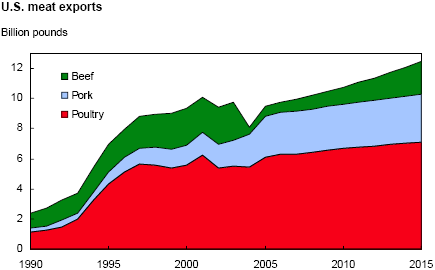



USDA Agricultural Baseline Projections to 2015
By the Office of the Chief Economist, World Agricultural Outlook Board, USDA - This report provides longrun baseline projections for the agricultural sector through 2015. Projections cover agricultural commodities, agricultural trade, and aggregate indicators of the sector, such as farm income and food prices.
Abstract
The projections are based on specific assumptions regarding macroeconomic conditions, policy, weather, and international developments. The baseline assumes that there are no shocks due to abnormal weather, further outbreaks of plant or animal diseases, or other factors affecting global supply and demand.
The Farm Security and Rural Investment Act of 2002 and The Energy Policy Act of 2005 are assumed to remain in effect through the projection period. Additionally, the Agricultural Reconciliation Act of 2005 is assumed to be in force. The baseline projections are one representative scenario for the agricultural sector for the next decade. As such, the baseline provides a point of departure for discussion of alternative farm sector outcomes that could result under different assumptions. The projections in this report were prepared in October through December 2005, reflecting a composite of model results and judgment-based analysis.
Steady domestic and international economic growth and gains in population strengthen demand for food and agricultural products in the baseline, providing a favorable demand setting for the U.S. agricultural sector. Additionally, strong expansion of corn-based ethanol production is projected, reflecting renewable fuel provisions in the Energy Policy Act of 2005. Although trade competition will continue to be strong, the United States will remain competitive in global agricultural markets.
Thus, increases in global consumption and world trade result in gains in U.S. agricultural exports. Combined with growing domestic demand for agricultural products, overall farm cash receipts rise. Rising production expenses and lower government payments, however, offset gains in cash receipts and other sources of farm income, keeping net farm income relatively stable from 2006 to 2015, after declining from historically high levels in 2004 and 2005.
Contents
- A Note to Users of USDA Baseline Projections
- Baseline Projections on the Internet
- Baseline Contacts
- Acknowledgments
- Introduction
- Overview of Baseline Assumptions and Projections
- Macroeconomic Assumptions
- Crops
- Livestock
- U.S. Agricultural Sector Aggregate Indicators Farm Income, Food Prices, and U.S. Trade Value
- Agricultural Trade
- List of Tables
Livestock
Livestock sector projections over the baseline period reflect increasing production, strong domestic demand, and strengthening exports for meat. Meat exports grow through the projection period as global incomes rise and meat demand increases. The baseline assumes a gradual rebuilding of U.S. beef exports to Japan and South Korea. While overall meat exports benefit from stronger foreign economic growth in the baseline, U.S. beef exports do not return to levels attained prior to the December 2003 discovery of bovine spongiform encephalopathy (BSE) in Washington State.
With rising grain prices, due largely to expansion of corn-based ethanol production, returns to U.S. red meat production are generally lower than in recent years, slowing beef and pork production gains, particularly in 2010-15. Larger increases in poultry output result in poultry becoming a larger proportion of total U.S. meat consumption. Overall, annual per capita consumption of red meats and poultry grows from 220 pounds in 2005 to 231 pounds in 2015.

Poultry production continues to rise, but less rapidly than during the 1990s due to the maturity of domestic demand and slower export growth.
The trend toward larger livestock systems continues throughout the baseline period. Efficiency gains allow production to expand while real prices generally decline. Production of all meats slows in the second half of the projections, reflecting higher feed costs as more corn is used in the production of ethanol.
-
The poultry sector has benefited from gains in efficiency at both the production and processing levels that reflect economies of scale associated with the industry’s horizontal and vertical integration. Projected gains in efficiency over the next decade are smaller than in the past 25 years.

Livestock prices are projected to average somewhat lower than the high levels of 2004, with producer returns generally lower as well.

U.S. consumers buy more meat, but spend a smaller proportion of disposable income for these purchases, continuing a long-term trend. Over the next 10 years, consumer meat expenditures decline from about 2 percent to 1.3 percent of disposable income. Poultry expenditures continue to increase as a share of consumer spending on meats.

Higher levels of total per capita meat consumption are projected over the next decade, largely reflecting continued increases in poultry consumption. On a retail-weight basis, per capita consumption rises to 231 pounds from the 2005 level of 220 pounds.
-
Although declining toward the end of the projections, per capita consumption of beef remains at relatively high levels through the baseline because of strong domestic demand for high-quality beef. Additionally, although beef exports grow, they do not return to 2003 levels in the projections, thereby limiting price increases seen by U.S. consumers.
-
Pork consumption remains stable at about 50-51 pounds per person throughout the projections.
-
Per capita consumption of relatively lower priced poultry increases throughout the baseline, allowing poultry to gain a larger share of total meat consumption and meat expenditures.

U.S. meat exports rise throughout the baseline period as global economic growth increases demand for meats. A gradual recovery in beef exports to markets such as Japan and South Korea is also critical to the projections. The baseline assumes that Brazil and Argentina will not be recognized as free of foot-and-mouth disease (FMD) by key importing countries, such as Japan, which limits trade competition in those markets.
Poultry
-
U.S. broiler export growth is expected to slow from the rate of the 1990s. Major U.S. export markets include Asia, Russia, and Mexico. Gains in these markets reflect strong economic growth and rising consumer demand for meat, with much of the higher demand being for poultry due to its lower cost relative to beef and pork. U.S. producers will face strong competition from other major broiler exporting countries, particularly Brazil. Poultry exports from countries affected by avian influenza, such as Thailand, China, and Vietnam, are expected to be limited to fully cooked products.

The sharp decline in beef exports in 2004 lowered the overall meat export share of the total value of domestically produced meat from about 11 percent in 2003 to under 8 percent, based on a measure that weights exports of beef, pork, and chicken by farm-level prices. While U.S. meat exports increase to over 11 percent of production value by the end of the projections, the domestic market remains the dominant source of overall meat demand.
Further Information
To continue reading this article, please click here
Source: U.S. Department of Agriculture, Economic Research Service - February 2006








